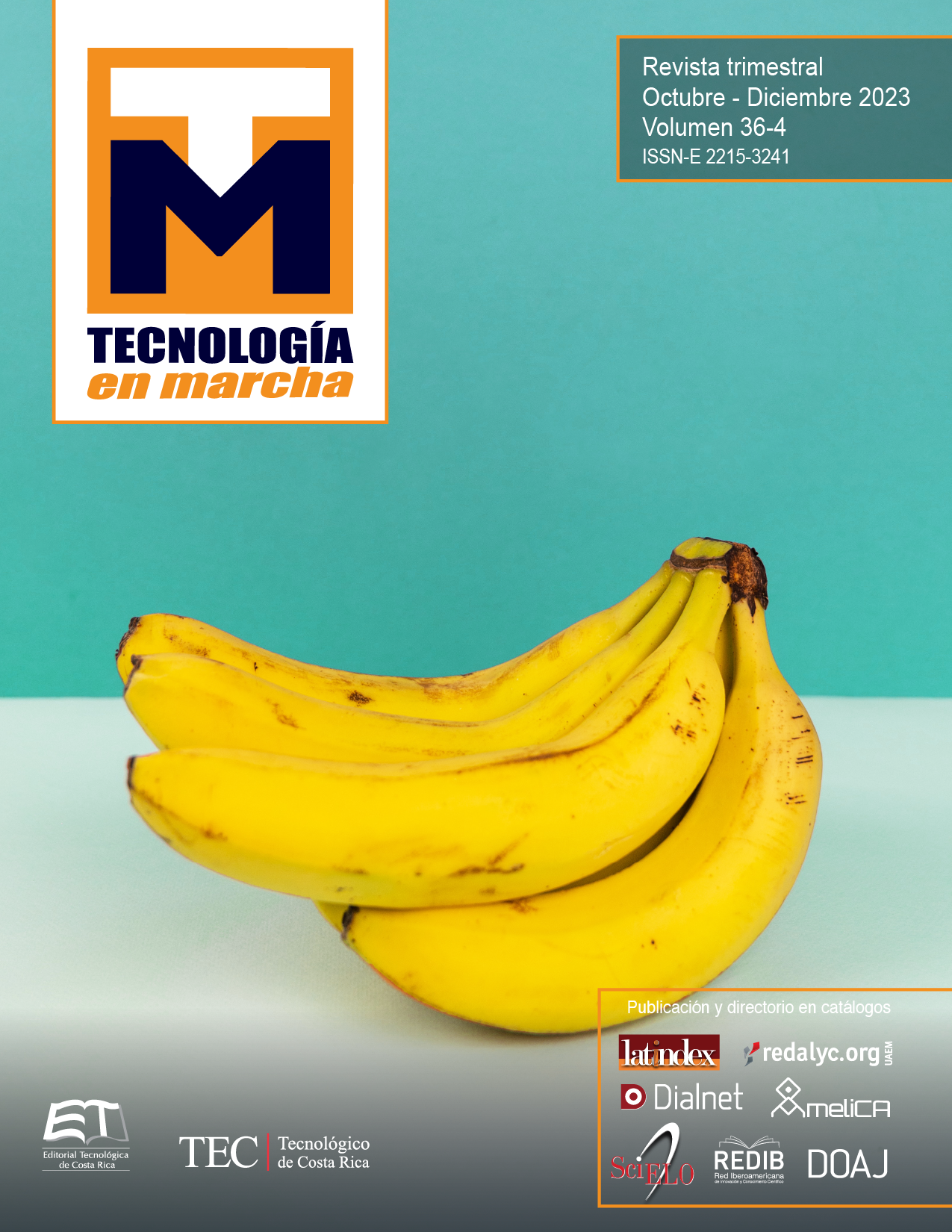Design of two proposals for soil conservation works to mitigate damage in a land with gully-type erosion problems, Los Santos area, Costa Rica
Main Article Content
Abstract
The conservation of the soil resource represents a preventive measure in the adequate use for current and future populations, however, in recent years the impact of climate change is increasingly common; with damage are tangible and often difficult to overcome. Additionally, producers do not always have the tools and technical support to make a combined use of the productive practice with soil conservation and this prevents preventive actions in the face of accelerated soil erosion by water. In this article, two design proposals for soil conservation works are presented that seek to mitigate the damage present on a farm in San Pedro Tarrazú, Costa Rica, where the problem of gully-type soil erosion is found. Hydrological variables and characteristics of the soil under study were determined to calculate soil loss by means of the universal soil loss equation (RUSLE), resulting in an average soil loss of 20.54 tons per hectare per year. year. Hence, the implementation of the designed conservation works is the key to significantly reduce soil loss. These works consisted of the design of terraces, trap-type infiltration ditches, live barriers, contour crops and trees for shade and soil tying.
Article Details

This work is licensed under a Creative Commons Attribution-NonCommercial-NoDerivatives 4.0 International License.
Los autores conservan los derechos de autor y ceden a la revista el derecho de la primera publicación y pueda editarlo, reproducirlo, distribuirlo, exhibirlo y comunicarlo en el país y en el extranjero mediante medios impresos y electrónicos. Asimismo, asumen el compromiso sobre cualquier litigio o reclamación relacionada con derechos de propiedad intelectual, exonerando de responsabilidad a la Editorial Tecnológica de Costa Rica. Además, se establece que los autores pueden realizar otros acuerdos contractuales independientes y adicionales para la distribución no exclusiva de la versión del artículo publicado en esta revista (p. ej., incluirlo en un repositorio institucional o publicarlo en un libro) siempre que indiquen claramente que el trabajo se publicó por primera vez en esta revista.
References
H. Fang, “Impacts of rainfall and soil conservation measures on soil, SOC, and TN losses on slopes in the black soil region, northeastern China,” Ecol. Indic., vol. 129, p. 108016, 2021, doi: 10.1016/j.ecolind.2021.108016.
FAO, “Agronoticias: Actualidad agropecuaria de América Latina y el Caribe,” 2015. http://www.fao.org/in-action/agronoticias/detail/es/c/516589/#:~:text=%22El 10%25 de Costa Rica,de la Desertificación de Tierras.
P. Rivera Ortiz, J. E. Rivera Larraga, E. Andrade Limas, F. de la Garza Requena, B. Castro Meza, and F. Belmonte Serrato, “Gully erosion measurement with satellite images.,” Medicion la Eros. en carcavas por medio imagenes satelite., vol. 32, no. 1, pp. 13–21, 2014, [Online]. Available: http://portal.chapingo.mx/terra/index.php?module=resumenes&id=321013.
W. Halecki, E. Kruk, and M. Ryczek, “Loss of topsoil and soil erosion by water in agricultural areas: A multi-criteria approach for various land use scenarios in the Western Carpathians using a SWAT model,” Land use policy, vol. 73, no. October 2017, pp. 363–372, 2018, doi: 10.1016/j.landusepol.2018.01.041.
I. Asensio, M. Ramón, G. Blanquer, and J. Manuel, “La ecuacion universal de perdida de suelo (USLE),” Univ. Politec. Val., vol. 1, no. 1, p. 10, 2012, [Online]. Available: https://riunet.upv.es/handle/10251/16849.
B. Grum et al., “Catena water harvesting techniques on event-based hydrological responses and sediment yield at a catchment scale in northern Ethiopia using the Limburg Soil Erosion Model ( LISEM ),” Catena, vol. 159, no. September 2016, pp. 20–34, 2017, doi: 10.1016/j.catena.2017.07.018.
ICAFE, “Tarrazú,” 2015. http://www.icafe.cr/nuestro-cafe/regiones-cafetaleras/tarrazu/.
G. Almoza, Yeleine; Schiettecatte, Wouter; Medina, Hanoi; Alonso, “El uso de datos pluviométricos para la determinación del factor erosividad de las precipitaciones en el modelo RUSLE,” Rev. Ciencias Técnicas Agropecu., vol. 17, no. 1, pp. 38–43, 2008, [Online]. Available: http://www.lamolina.edu.pe/zonasaridas/za11/pdfs/ZA11 00 art11.pdf.
W.-G. Vahrson, “El potencial erosivo de la lluvia en Costa Rica,” Agron. Costarric., vol. 14, no. 1, pp. 15–24, 1990, [Online]. Available: http://www.mag.go.cr/rev_agr/v14n01_015.pdf.
E. Lianes, M. Marchamalo, and M. Roldán, “Evaluación del Factor C de la Rusle para el Manejo de Coberturas Vegetales en el Control de la Erisón en la Cuenca del Río Birrís, Costa Rica.,” Agron. Costarric., vol. 33, no. 2, pp. 217–235, 2009, [Online]. Available: www.mag.go.cr/rev_agr/v33n02_217.pdf.
E. Gürtekin and O. Gökçe, “Estimation of erosion risk of Harebakayiş sub-watershed, Elazig, Turkey, using GIS based RUSLE model,” Environ. Challenges, vol. 5, no. June, p. 100315, 2021, doi: 10.1016/j.envc.2021.100315.
FAO - MAG, “Las Barreras Vivas Y Su Aplicación,” 1999, [Online]. Available: http://www.mag.go.cr/congreso_agronomico_xi/a50-6907-III_003.pdf.

